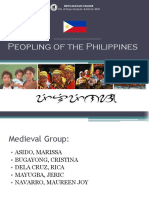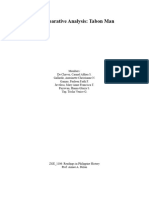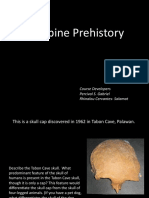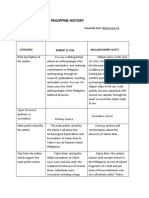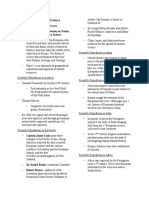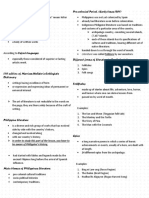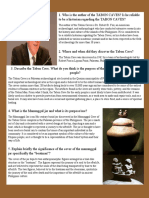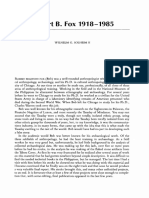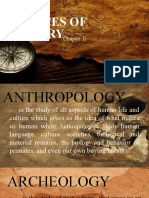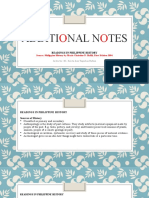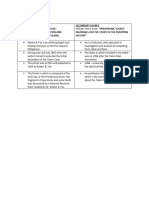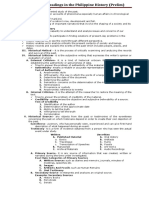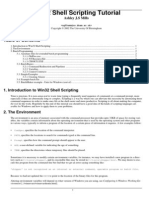0 ratings0% found this document useful (0 votes)
75 viewsHistory Reviewer
History Reviewer
Uploaded by
Viennalyn Cerillo1. The Tabon Cave skull cap discovery in the Philippines challenged H. Otley Beyer's theory that early Filipinos migrated in waves. The skull was dated to 22,000-24,000 years old, much older than Beyer's theories accounted for.
2. F. Landa Jocano proposed the "core population theory," arguing that bone fragments found across Asia indicated early humans in the region belonged to one population, with genetic growth and mixing over time giving rise to modern Southeast Asian populations.
3. William Henry Scott was an American anthropologist who studied Philippine history and debunked tales like the Maragtas, arguing they were not reliable sources for prehispanic history.
Copyright:
© All Rights Reserved
Available Formats
Download as PDF, TXT or read online from Scribd
History Reviewer
History Reviewer
Uploaded by
Viennalyn Cerillo0 ratings0% found this document useful (0 votes)
75 views6 pages1. The Tabon Cave skull cap discovery in the Philippines challenged H. Otley Beyer's theory that early Filipinos migrated in waves. The skull was dated to 22,000-24,000 years old, much older than Beyer's theories accounted for.
2. F. Landa Jocano proposed the "core population theory," arguing that bone fragments found across Asia indicated early humans in the region belonged to one population, with genetic growth and mixing over time giving rise to modern Southeast Asian populations.
3. William Henry Scott was an American anthropologist who studied Philippine history and debunked tales like the Maragtas, arguing they were not reliable sources for prehispanic history.
Copyright
© © All Rights Reserved
Available Formats
PDF, TXT or read online from Scribd
Share this document
Did you find this document useful?
Is this content inappropriate?
1. The Tabon Cave skull cap discovery in the Philippines challenged H. Otley Beyer's theory that early Filipinos migrated in waves. The skull was dated to 22,000-24,000 years old, much older than Beyer's theories accounted for.
2. F. Landa Jocano proposed the "core population theory," arguing that bone fragments found across Asia indicated early humans in the region belonged to one population, with genetic growth and mixing over time giving rise to modern Southeast Asian populations.
3. William Henry Scott was an American anthropologist who studied Philippine history and debunked tales like the Maragtas, arguing they were not reliable sources for prehispanic history.
Copyright:
© All Rights Reserved
Available Formats
Download as PDF, TXT or read online from Scribd
Download as pdf or txt
0 ratings0% found this document useful (0 votes)
75 views6 pagesHistory Reviewer
History Reviewer
Uploaded by
Viennalyn Cerillo1. The Tabon Cave skull cap discovery in the Philippines challenged H. Otley Beyer's theory that early Filipinos migrated in waves. The skull was dated to 22,000-24,000 years old, much older than Beyer's theories accounted for.
2. F. Landa Jocano proposed the "core population theory," arguing that bone fragments found across Asia indicated early humans in the region belonged to one population, with genetic growth and mixing over time giving rise to modern Southeast Asian populations.
3. William Henry Scott was an American anthropologist who studied Philippine history and debunked tales like the Maragtas, arguing they were not reliable sources for prehispanic history.
Copyright:
© All Rights Reserved
Available Formats
Download as PDF, TXT or read online from Scribd
Download as pdf or txt
You are on page 1of 6
HISTORICAL CONTEXT OF DOCUMENTS • Lived in the Cordilleras with the Ifugaos and
married Ligaya Gambuk, the daughter of
Philippine prehistory relies on theories since no one
the Ifugao chief
lived to recount the events that occurred, from
• Went back to U.S. to pursue doctoral
the emergence of the lands to the migration of
studies in anthropology in Harvard and
different races.
came back to lecture at U.P.
GEOGRAPHIC ORIGINS THEORIES: • Spending his life in the Cordilleras, he noted
that different groups have different
a.) Land Bridge Theory features which sparked his theory.
Exerts that islands were product of high lands TABON CAVE SKULL CAP DISCOVERY
elevation caused by the melting of ice during
the last Ice Age. The theory of Beyer was shaken after the
discovery of the Tabon Cave skull cap (Taong
Denied by Fritjof Voss, a geologist. Tabon). It was discovered by local bird nest
b.) Tectonic Plates Theory hunters and gave it to the National Museum
whose Dr. Robert Fox was the chief
Islands were formed due to the collision of anthropologist.
active plates caused by volcanic eruptions.
Dr. Robert Fox
Came from the Continental Drift Theory by
German geophysicist, Alfred Wegener in 1912. • Born on May 11, 1918 in Galvestone, Texas
• Earned Bachelor of Arts in Anthropology
PEOPLE ORIGINS THEORIES: from the University of Texas in 1944
a.) Wave Migration • Earned Ph.D. in the same field in University
of Chicago in 1954
• J. Montano (1884-1885) was the earliest • Carbon dated the found skull and shows
scholar who classified Filipinos into that it was 22,000 – 24,000 years old
groups or special racial groupings using • 1962 -1966, Fox and his Filipino team
anthropomorphic methods. These excavated the Tabon Cave.
groups were: Negritos, Malays, and
Indonesians. THE TABON CAVE EXCAVATION
• Theorized by Dr. H. Otley Beyer that the Initial Excavation (June and July 1962)
inhabitants of the island came as
migrants in groups or waves. Using the • Scattered fossil bones of three individuals
classification of Montano, Beyer including a large fragment of a frontal
specifically classified the migrants as bone with the brows and portions of the
well as the time of their arrival. nasal bones.
• Unfortunately, the area had been
Dr. H. Otley Beyer disturbed by Magapode birds.
• American Anthropologist, The Father of • Was not possible in 1962 to establish
Philippine Anthropology (1833 – 1966) association of these bones with a flake
• Born on June 13, 1833 in Edgewood, Iowa assemblage.
• First interest in the Philippines sparked in • Either related to flake assemblage II or flake
1904 after visiting the Philippine Exhibit in St. assemblage III.
Louis, Missouri. • The found fossil bones are those of Homo
• Graduated in Chemistry at Iowa State Sapiens.
University. • Excavations in Cagayan Valley yielded
• Took up Masters in Chemistry in the fossils of extinct animals in Callo Cave.
University of Denver. • Metatarsal of a far older Homo sapien was
• Volunteered to go to the Philippines to found, older than Tabon Man, which lead
teach Filipinos during the American Dr. F. Landa Jocano to formulate core
colonization. population theory.
DR. F. LANDA JOCANO • Fr. Thomas Santaren (Janiuay, Iloilo in 1858)
wrote the Spanish version which was
• Filipino Anthropologist (1930 – 2013)
published as an appendix to Fr. Angel
• Born on February 5, 1930 in Cabuatan,
Perez’s book: Igorotes studio geografica
Iloilo.
sobre algunos distrito del norte de Luzon
• Worked his way to graduate at Arellano
(Igorot geographic survey on some districts
High School but went back to Iloilo to finish
of Northern Luzon).
his Bachelor of Arts Degree in Central
Philippine University in 1957. DR. WILLIAM HENRY SCOTT
• Interested in the Philippine folklore, wrote to
• Born on July 10, 1921 in Detroit, Michigan to
Dr. Fox and was given a job at the National
a Protestant Family.
Museum as a janitor.
• Interest in archeology sparked when he
• Became a part of the museum’s typing
got a scholarship in Cranbrook.
pool which exposed him to the museum’s
• Joined the U.S. Navy in 1942-1946 and
data and wrote about Philippine legends
fought in the WWII.
surrounding plant and animal life.
• Joined the Espiscopalian mission in China
• Diwang Kayumanggi
where he taught and studied in Shanghai,
• From janitor to research aid to a scientist
Yangchow, and Beijing in 1949.
• Masters and Doctorate in Anthropology in
• Victim of alien deportation in 1949.
University of Chicago as well as Ph.D.
• Went to Yale University in 1951 to learn
• Went back to U.P. to teach where at that
Chinese language and literature and took
time the Tabon Cave finds have already
masters degree in Columbia University.
been a breakthrough in Philippine
• Went back to the Military to fight in the
Anthropology.
Korean War in 1950-1953.
PEOPLE ORIGINS THEORIES: • Taught English and history in St. Mary’s
School in Sagada, Mt. Province.
1b.) Core Population Theory
• Earned his Ph.D. in the Philippines at the
• Bone fragments were found in Java, University of Santo Tomas (Prehispanic
Indonesia, Peking, and China have the Source Materials for the Study of Philippine
same features found in the Tabon Man, in History, 1968).
which Jocano theorized that these people • His book was revised in 1984, incorporating
belong to one population more prehispanic materials that he
• Pre-modern humans represent the core debunked including the Maragtas tale
population which genetic growth is and Code of Kalantiaw.
evident as later groups of people trickled
THE MARAGTAS TALE
into the region, giving rise to new
populations which we now recognize as A story of ten Bornean Datus who sailed/fled using
contemporary, Southeast Asians. a balangay from Borneo to escape from the cruel
Sultan Makatunaw. Reached the land of Panay
2b.) Movement Theory
where they met a Negrito Chieftain, Marikudu.
• Proposed by Peter Bellwood in 1985. They gave his wife, Maniwantiwan a golden
• Austronesians, people from Southern China salakot and they were permitted to inhabit the
who traveled via Taiwan and Batanes land.
between 4,000 – 5,000 BC.
The Ten Datus were:
DOCUMENTS THAT SUPPORT THE WAVE MIGRATION
• Datu Puti – Expedition Leader
THEORY
• Datu Sumakwel – The Leader
• This document is today known as the • Datu Bangkaya
Maragtas Tale and has two versions. • Datu Paiburong
• Datu Padohinog
• Datu Dumangsol • Can also be an original source (unpolished,
• Datu Dumangsil uncopied, untranslated as it emanated
• Datu Dumalogdog from the hands of the author.
• Datu Lubay
Secondary Sources
• Datu Balensusa
• Testimony of anyone who’s not an
THE CODE OF KALANTIAW
eyewitness.
• Datu Kalantiaw, a descendant of Datu
External Criticism (Authenticity)
Sumakwel, enforced a code of rules during
his time as Datu called The Code of a) Provenance or origin of the document
Kalantiaw. These documents that seemed b) Indicated date when the document was
to be primary sources, which when written
authenticated, are the pieces of c) Author’s handwriting or signature
evidences to support the wave migration d) Anachronistic style of the author (use of
theory in utmost detail. The said document words, idioms, punctuations, and
would document the level of civilization semantics)
the settlers would have developed. The set e) Anachronistic references to events
of laws was translated and published
between 1903-1909 in English by the former Internal Criticism (Credibility)
director of National Library and Museum, a) Verisimilitude or similarity to other
Dr. James A. Robertson. documents
• The supposedly ancient documents that b) Author’s mental processes
would paint our prehispanic past were c) Author’s ability or willingness to tell the truth
revisited and re-examined by Scott on his d) Can be corroborated with other
way towards earning his Ph.D. His work testimonies and materials
Prehispanic Source Materials for the study
of Philippine History was an outstanding DEBUNKING THE MARAGTAS TALE
execution of how historical analysis is done • The Maragtas Tale was accepted as
using both external and internal criticisms. historical facts among the academic
GOTTSCHALK ON HISTORICAL METHOD AND circles when it was introduced by
HISTORIOGRAPHY Robertson in 1918, until 1984 when the book
by Scott went off in the press, though
Historian’s Weapons in the Arsenal expunging it from history books took a long
• Historical Analysis while due to institutional and academic
• Historiography hurdles.
• Scott expunged the tale from history books
HISTORICAL ANALYSIS has four procedures: by means of examining the author, Pedro
Montecarlo.
a) Selection of subject
b) Collection of sources PEDRO MONTECARLO
c) Determination of source’s
genuineness • Born in Miag-ao, Iloilo on October 15, 1850
d) Extraction from credible particulars • Graduated from Seminario Colegio de
Jaro in 1865, was twice married and had
Two kinds of sources: five children
• Served as Teniente Mayor in 1891 and
1. Primary sources
Gobernadorcillo in 1892-1894.
2. Secondary sources
• Became a local hero during the revolution
Primary Sources and the American Invasion both for his
leadership and diplomacy
• Testimony of an eyewitness or any witness
that was present in the event.
• Served as Liaison Officer during the THE INCREDIBLE CODE OF KALANTIAW
American occupation and was the first
1. Lack of historical evidence
president of Miag-ao (1901-1903)
• There are simply no written or pictorial
• Was also known as a poet in both the
documents from that time in Philippine
vernacular and Spanish, and a few of his
history. There are no documents from other
Visayan songs have survived.
countries, there is no evidence that
• Died on April 13, 1909 and is memorialized
Philippine culture ever spawned such
in the name of the Local Philippine
barbaric set of laws. Early Spanish
Constabulary base, Camp Montecarlo, at
accounts even tells that Filipino at the
whose gate his statue stands.
allowed even the most serious law breakers
MONTECARLO’S FOREWORD TO THE READERS to pay a fine or be placed in servitude for
a time in cases of debt.
KALANTIAW: THE HOAX
• Francisco Colin wrote in 1663 that unlike
The story of Datu Kalantiaw is often assumed to the rules in the Code of Kalantiaw, the
be just one of the legends contained in an punishment of crimes of violence depends
ancient and mysterious document called the on the severity of the case.
Maragtas. However, the Maragtas was actually 2. Lack of evidence for a Kalantiaw legend
just a book written in 1907 by Pedro Montecarlo in • The Spaniards never recorded any Filipino
which he compiled local legends of the Visayas Legend about Kalantiaw. If they were
from mainly oral traditions and a few written aware of such legend, they had no reason
documents that were fairly modern in their origins. to supress it because those Spaniards who
Montecarlo never mentioned a chief by the were sympathetic to the Filipino could
name of Kalantiaw in the Maragtas. have presented the mere existence of the
code as proof that their ancestors were
Some of the Maragtas legends have long been civilized
a part of Visayan folklore and they are a source of • Aklanon historian, Digno Alba, looked for
fierce pride for many Viasayan today. The stories Kalantiaw in local folklore in the 1950’s and
of the ten datus have told for generations and found nothing. On May 5, 1967, William H.
they are perfectly believable, as far as legends Scott wrote to Alba asking if he heard of
go, if we put aside the modern additions such as old folks relay the story of Kalantiaw when
obviously phoney original manuscripts and the Alba was still a child, in which Alba replied
use of precise but utterly uncorroborated dates on May 15, 1967 that he had not heard that
from the pre-colonial era. story be told by even a single old man in
THE INCREDIBLE CODE OF KALANTIAW the present generation.
3. The source of the Kalantiaw myth
Throughout the latter half of the 20th century • The ultimate origin of Kalantiaw was traced
Filipino students were taught about the vicious by Scott back to a single person who
and bizarre laws that were said to have enacted definitely did not live in the 1400’s. He was
by one Datu Kalantiaw in 1433 on Panay. The Jose E. Marco of Pontevedra, Negros
punishments were extremely brutal, having no Occidental and in 1913 he claimed to
relational to the severity of the crime committed. have discovered the Pavon documents
There are three good reasons why we should not which contain the Code of Kalantiaw but
believe the story: were in fact Marco’s own creation.
Kalantiaw became the most successful of
• Lack of historical evidence many hoaxes in Marco’s career of almost
• Lack of evidence for a Kalantiaw Legend 50 years as a forgery and fraud.
• The source of the Kalantiaw myth
THE ORIGIN OF KALANTIAW AND THE PAVON 3. Era Confusion
MANUSCRIPTS • Pavon was confused about his own era
• Dedicated Leyendes to the King of Spain
• Kalantiaw’s name first appeared in print in
on August 1, 1839, however Spain had no
July of 1913 in an article entitled
king at that time
Civilizacion Prehispania published in
• Used the word “microbe” in 1838 but the
Renacimiento Filipino.
word was invented in 1878.
• The article mentioned 16 laws encated by
• Included the pre-Hispanic Alphabet that
Datu Kalantiaw in 1433, and a fort that he
Fr. Francisco Deza had supposedly
built in Gagalangin, Negros which was
recorded in 1543 but he was not born until
destroyed by an earthquake in the year
1620.
A.D. 435.
4. Pavon’s Writing
• The article was written by Manuel Artigas
• Erratic spelling of the two volumes of
who only a year before had provided
Leyendes
footnotes to a poorly written essay by Jose
Marco, Resena historica de la Isla de JOSE MARIA PAVON
Negros
• Friar Jose Maria Pavon y Araguro
• More details emerged when Jose Marco
acknowledge many sources of
donated five manuscripts to the Philippine
information for his books; untraceable
Library and Museum in 1914
iformants, unknown documents and
• Among the documents were: Las antiguas
authors who were already deceased or
leyendes de la Isla de Negros, a two-
not even born yet. Which makes Pavon’s
volume leather bound work that was
life was dubious.
written by a Friar Jose Maria Pavon in 1838
• He claimed about things that he has done
and 1839.
but no records to support it.
• The origical Code was purportedly in the
• The Guia de Forasteros or Foreigner’s
possession of a Panay Datu in 1614. At the
Guide listed Pavon with a D. (for Don)
time pavon’s writing in 1839 was
which connotes that he is a secular priest,
supposedly owned by Don Marcelio Orfila
but Pavon often signed his name as “Fray
of Zaragoza
Jose Maria Pavon”.
• Pavon was the priest of Himamaylan,
Negros in 1840’s. When the town was EMBELLISHMENTS TO THE MYTH
looted, Marco’s father was among the
looters and mistakenly took a chest full of • Since the making of the Kalantiaw Hoax
papers when he thought it was coins and by Jose Marco, frauds and scholars
jewelries. began to build history on the foundation
of the artificial legend.
MISTAKES IN THE PAVON MANUSCRIPT • Marco and his creation attained a veneer
of legitimacy when Dr. James A.
1. The Content
Robertson translated the code in 1917.
• The title of the code is the 17 theses or laws
• In the same year, Josue Soncuya (a native
of the Regulos in use in 150 since 1433 but
of Banga, Aklan) published a Spanish
there are actually 18 laws enlisted which
version of the Code in six chapters of his
cover over forty offences, and not 16 laws
Historia Prehispania and he concluded
as reported by Artigas in 1913.
that the code was written for Aklan,
2. The Dates
Panay not Negros.
• In 1800s it was still common to abbreviate
• The legend was transplanted into the soil
dates by omitting the first one or two digits
of Panay.
of a year. (If the year is 150, then it mustve
• The crafted legend became International
been the 1150, not 1500.
and known to other scholars and
historians.
HISTORY OF KALANTIAW REFUTED • However, the ghost of Kalantiaw
continues to haunt the Filipinos even 40
• Jose Marco continued to produce
years after the hoaxes were exposed.
forgeries almost until his death in 1963 but
Where, even if old textbooks are revised,
with ever diminishing success. In 1950s,
the fictituous code of Kalantiaw and
genuine scholars could no longer take him
Maragtas remained untouched even if
seriously despite the Kalantiaw being
recent events were added.
known.
• In 1965, Bibliographer, Mauro Garcia
• Today, some people still cite the courage
suggested William Henry Scott for his thesis
and wisdom of Kalantiaw as they
that he examines the history of the
continue to heap accolades upon him
Philippines before the arrival of the
and the oblivious recipients of those
Spaniards.
Kalantiaw awards.
• Garcia received several fake documents
from Jose Marco which made him
suspicious of Marco’s first discoveries
• Scott focused his investigation by tracing
the original source of every single
reference to the pre-Hispanic history of the
Philippines in the four standard college text
books in use at that time.
THE DIE-HARD LIE
• Scott’s expose did not have an immediate
effect on the Filipino society since the
concept of Kalantiaw was already
established.
• Some Filipino historians had already
discarded the Code of Kalantiaw even
before Scott’s thesis was published.
• However, Professor Gregorio Zaide
examined Scott’s thesis,despite the
opportunity to challenge Scott’s thesis,
Zaide remained silent and continued to
endorse the myth and even added his own
details in his books
• Soon after the death of Zaide, his daughter
Sonia Zaide took over and revised all the
books that she co-authored and removed
most of the material based on the Marco
hoaxes.
You might also like
- Core Population Pre HistoryDocument16 pagesCore Population Pre HistoryKhai McDoughnutNo ratings yet
- Peopling of The PhilippinesDocument47 pagesPeopling of The Philippinesjeric mayugba100% (2)
- Migration TheoriesDocument53 pagesMigration TheoriesJester Ambojnon Tukling100% (1)
- Cairn PDFDocument20 pagesCairn PDFlawdawgNo ratings yet
- The Seven Segment DisplayDocument5 pagesThe Seven Segment DisplayTewodros Kassahun100% (2)
- RPH Tabon Man Group WorkDocument6 pagesRPH Tabon Man Group WorkGabby GallardoNo ratings yet
- UNIT 1 - PART 2 - Sources of History 1Document29 pagesUNIT 1 - PART 2 - Sources of History 1ASHLEY JADE NAIGANNo ratings yet
- Anthro and SociologistsDocument10 pagesAnthro and SociologistsJosetteNo ratings yet
- Tabon Cave: Land Bridge or Waves of Migration TheoryDocument2 pagesTabon Cave: Land Bridge or Waves of Migration TheoryJerome SurimaNo ratings yet
- Migration TheoryDocument3 pagesMigration TheoryZhiezle Lyka Arevalo50% (2)
- Tabon CavesDocument10 pagesTabon CavesCrystal May Juni FontanosNo ratings yet
- Module 2.2 Philippine PrehistoryDocument15 pagesModule 2.2 Philippine PrehistoryAbdulhalim MacadatoNo ratings yet
- Chapter 2 Philippine Pre History CanvasDocument39 pagesChapter 2 Philippine Pre History CanvasAina AguirreNo ratings yet
- The Pineapple Is A Traditional American Symbol of HospitalityDocument17 pagesThe Pineapple Is A Traditional American Symbol of HospitalityKline MicahNo ratings yet
- The Tabon Cave: (Human Remains and Artifacts) : M/3Cl Hamchawan, Neil Archie GDocument2 pagesThe Tabon Cave: (Human Remains and Artifacts) : M/3Cl Hamchawan, Neil Archie GSicat Mark BantiyanNo ratings yet
- Primary Source Analysis: ReferenceDocument5 pagesPrimary Source Analysis: ReferenceCrizelle NayleNo ratings yet
- Human Evolution 1Document5 pagesHuman Evolution 1Vivek RaiyaniNo ratings yet
- Handouts Philippine HistoryDocument8 pagesHandouts Philippine HistoryshadowisservingNo ratings yet
- EmmieDocument4 pagesEmmiekhaye26No ratings yet
- Presented By: DEAN RUFFEL R. FLANDEZ As A Requirement of The Course History 211 - Early To 17 Century Philippine HistoryDocument29 pagesPresented By: DEAN RUFFEL R. FLANDEZ As A Requirement of The Course History 211 - Early To 17 Century Philippine HistoryClaire AbapoNo ratings yet
- The Fallacies of The DeepDocument4 pagesThe Fallacies of The DeepDexter CaroNo ratings yet
- History First InhabitantsDocument1 pageHistory First InhabitantsMystical AbyssNo ratings yet
- Name: Elmer R. Macasling Course & Year: Beed - Iii (Irregular)Document2 pagesName: Elmer R. Macasling Course & Year: Beed - Iii (Irregular)Joh Na AlvaradoNo ratings yet
- 21st Century LiteratureDocument6 pages21st Century LiteratureMark Carlo BautistaNo ratings yet
- Pre Colonial PeriodDocument10 pagesPre Colonial PeriodDenielle Joyce Macalino100% (1)
- Peopling of The Archipelago 3Document19 pagesPeopling of The Archipelago 3Gee LeeNo ratings yet
- Share GE 2B-READINGS-WPS OfficeDocument2 pagesShare GE 2B-READINGS-WPS OfficeMirely BatacanNo ratings yet
- Questions & Challenges in Philippine HistoryDocument27 pagesQuestions & Challenges in Philippine HistoryErin Hojilla67% (6)
- Readings in Philippine History 1Document2 pagesReadings in Philippine History 1Kobe Kyle Ramones GelaNo ratings yet
- Anthropologie SDocument4 pagesAnthropologie SPaul James CabasagNo ratings yet
- PhlegerDocument3 pagesPhlegerMuhamad Kuncoro BayuajiNo ratings yet
- The Spread of Western ScienceDocument2 pagesThe Spread of Western ScienceyoltorshuulNo ratings yet
- 21st Lit ReviewerDocument9 pages21st Lit ReviewerCristobal Gutierrez IIINo ratings yet
- Biografia Irving RouseDocument27 pagesBiografia Irving RouseGuillermo BisbalNo ratings yet
- Phil Histo-HandoutDocument3 pagesPhil Histo-HandoutJessaMae AlbaracinNo ratings yet
- 1 The Peopling in The PhilippinesDocument2 pages1 The Peopling in The Philippinescaro.loriemaevNo ratings yet
- Module 1 Prehistoric Era of The PhilippinesDocument22 pagesModule 1 Prehistoric Era of The PhilippinesCaraig Jonh PatrickNo ratings yet
- The Cornplanter Medal For Iroquois ResearchDocument3 pagesThe Cornplanter Medal For Iroquois ResearchPentortoiseNo ratings yet
- Lesson 1 Intellectual RevolutionDocument129 pagesLesson 1 Intellectual RevolutionMuttia SelgasNo ratings yet
- Robert Bradford FoxDocument12 pagesRobert Bradford FoxMallari MarjorieNo ratings yet
- Abrogar Act2Document2 pagesAbrogar Act2AIDAN GYLE ABROGARNo ratings yet
- Robert B. Fox 1918-1985: Wilhelm G. Solheim IiDocument7 pagesRobert B. Fox 1918-1985: Wilhelm G. Solheim IiRey John Nullas MonjeNo ratings yet
- Henry Otley BeyerDocument2 pagesHenry Otley BeyerLorenzo Velasco100% (1)
- STS ReviewerDocument10 pagesSTS Reviewernexus.pj13No ratings yet
- Prehistory of The Philippines: Stone-Age-humans Arrive (30000 BC)Document8 pagesPrehistory of The Philippines: Stone-Age-humans Arrive (30000 BC)marfe_joevelynNo ratings yet
- A.1.1 Philippine Literary HistoryDocument47 pagesA.1.1 Philippine Literary HistoryAnna Dalin-Mendoza50% (2)
- Report Indigenous Different Theories of The Peopling of The PhilippinesDocument7 pagesReport Indigenous Different Theories of The Peopling of The PhilippinesRonibe B MalinginNo ratings yet
- Rouse - 1954 - Necrology. Wendell C. Bennett 1905-1953Document7 pagesRouse - 1954 - Necrology. Wendell C. Bennett 1905-1953Luis Flores BlancoNo ratings yet
- The Philippine Pre-HistoryDocument54 pagesThe Philippine Pre-HistoryNICOLEVERA CRUZNo ratings yet
- The Greater Malayan ConfederationDocument6 pagesThe Greater Malayan ConfederationArkitel toNo ratings yet
- Chapter 2 Sources of HistoryDocument14 pagesChapter 2 Sources of HistoryApril CaringalNo ratings yet
- RPH Reviewer - Groups 1 To 4Document32 pagesRPH Reviewer - Groups 1 To 4delacruzlatsNo ratings yet
- ADDITIONAL NOTES On Readings in Philippine HistoryDocument19 pagesADDITIONAL NOTES On Readings in Philippine HistoryTea AnnNo ratings yet
- Lesson 1A Intellectual RevolutionDocument55 pagesLesson 1A Intellectual RevolutionElmer T. RiveraNo ratings yet
- History 01 PrehistoryDocument7 pagesHistory 01 PrehistoryMarnold SalatanNo ratings yet
- Module 3 - History de Guzman, EugzDocument10 pagesModule 3 - History de Guzman, EugzSasota, Rizza J.No ratings yet
- Primary SourceDocument1 pagePrimary SourcekristanleyheinzjNo ratings yet
- Riph 111 Reviewer PrelimsDocument3 pagesRiph 111 Reviewer PrelimsAlexie Roselle SerranilloNo ratings yet
- Asuncion, Carlo M. - Philippine Anthropology EssayDocument3 pagesAsuncion, Carlo M. - Philippine Anthropology EssaycasuncionNo ratings yet
- Reviewer (GEN 004)Document12 pagesReviewer (GEN 004)Clarence ZamoraNo ratings yet
- A Burial Cave in Baja California The Palmer Collection, 1887From EverandA Burial Cave in Baja California The Palmer Collection, 1887No ratings yet
- Introduction To Win32 Shell ScriptingDocument9 pagesIntroduction To Win32 Shell ScriptingKishore BramhamdamNo ratings yet
- Question and Answer Chapter 7Document6 pagesQuestion and Answer Chapter 7NKMS:)No ratings yet
- Remuda Ranch RecipesDocument56 pagesRemuda Ranch RecipesMichelle MillerNo ratings yet
- Mix Design of Bituminous Concrete by Bailey MethodDocument6 pagesMix Design of Bituminous Concrete by Bailey Methodanon_370570207No ratings yet
- Thyristor or Silicon Controlled Rectifier TutorialDocument7 pagesThyristor or Silicon Controlled Rectifier Tutorialmarcoms75No ratings yet
- IT Task Technology in Military: Muhammad Athallah 107 Ricky Adrianto 114 Dessyana Damayanti 161 Daffa Ramadhan S 293Document9 pagesIT Task Technology in Military: Muhammad Athallah 107 Ricky Adrianto 114 Dessyana Damayanti 161 Daffa Ramadhan S 293LaNo ratings yet
- Business PlanDocument25 pagesBusiness Plansisondale02No ratings yet
- Series 35 Scissors Lift (PDFDrive)Document79 pagesSeries 35 Scissors Lift (PDFDrive)ARUN VISHWAKARMANo ratings yet
- I-Objectives: Science-CG - With-Tagged-Sci-Equipment - Revised - PDF (Deped - Gov.ph)Document4 pagesI-Objectives: Science-CG - With-Tagged-Sci-Equipment - Revised - PDF (Deped - Gov.ph)Kent Andojar MarianitoNo ratings yet
- Magnetic Effect of Current (Practice Questions)Document7 pagesMagnetic Effect of Current (Practice Questions)Somnath BanerjeeNo ratings yet
- Hubungan Jumlah Bunga, Jumlah Daun, Jumlah Anak Daun, Jumlah Cabang, Dan Tinggi Tanaman Terhadap Pertumbuhan Bibit Tanaman Kemuning (Murraya Paniculata (L.) Jack)Document4 pagesHubungan Jumlah Bunga, Jumlah Daun, Jumlah Anak Daun, Jumlah Cabang, Dan Tinggi Tanaman Terhadap Pertumbuhan Bibit Tanaman Kemuning (Murraya Paniculata (L.) Jack)Bayu MuhaiminNo ratings yet
- Chemistry Investigatory Project On PHDocument10 pagesChemistry Investigatory Project On PHswarnadeep dasNo ratings yet
- AEE 342 Aerodynamics II: Dr. Mohamed Salem ElmnefiDocument12 pagesAEE 342 Aerodynamics II: Dr. Mohamed Salem ElmnefiDilara Kevser ÇAKMAKNo ratings yet
- Marketing Activities Huyen Tran..Document2 pagesMarketing Activities Huyen Tran..Tuyền Nguyễn Thị ThúyNo ratings yet
- Cognitive and Psychopathological Aspects of Ehlers DanlosDocument5 pagesCognitive and Psychopathological Aspects of Ehlers DanlosKarel GuevaraNo ratings yet
- ECS-700 System OverviewDocument34 pagesECS-700 System OverviewIrfan AqibNo ratings yet
- Docker Cheat SheetDocument50 pagesDocker Cheat SheetabhinavsrivastavNo ratings yet
- Solution Sen Ghosh Mukhopadhyay Abstract Algebra 5 2 Cyclic Group-1Document5 pagesSolution Sen Ghosh Mukhopadhyay Abstract Algebra 5 2 Cyclic Group-1basakgourab00No ratings yet
- Autodesk Revit Training AgendaDocument8 pagesAutodesk Revit Training AgendaRajesh AgareNo ratings yet
- English Test Paper UTDocument5 pagesEnglish Test Paper UTkritikatusid17No ratings yet
- Respiratory System ExaminationDocument46 pagesRespiratory System ExaminationÑäd Éèm100% (1)
- Table For GulayanDocument4 pagesTable For GulayanRealou Escudero Añoso100% (1)
- Smc-Er3055 Manual PDFDocument32 pagesSmc-Er3055 Manual PDFNot ImportantNo ratings yet
- Aiwa HT-DV50 DVD Home Cinema System SMDocument12 pagesAiwa HT-DV50 DVD Home Cinema System SMRogelioMartinezNo ratings yet
- AEG Solar Brochure ENDocument13 pagesAEG Solar Brochure ENJitheshNo ratings yet
- Fluid Mechanics2Document6 pagesFluid Mechanics2cemaliNo ratings yet
- Sigl 3Document438 pagesSigl 3Gloringil BregorionNo ratings yet
- Gr-500exl RH B GDocument2 pagesGr-500exl RH B GLaemarc Aler EstradaNo ratings yet

